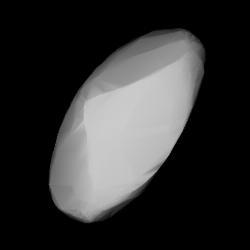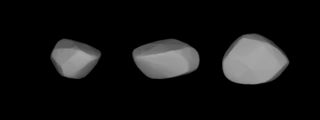Related Research Articles
4349 Tibúrcio, provisional designation 1989 LX, is a dark asteroid from the central region of the asteroid belt, approximately 29 kilometers in diameter. It was discovered on 5 June 1989, by German astronomer Werner Landgraf at ESO's La Silla Observatory in northern Chile.
Athalia, provisional designation 1903 ME, is a carbonaceous Themistian asteroid from the outer regions of the asteroid belt, approximately 40 kilometers in diameter. It was discovered on 20 September 1903, by German astronomer Max Wolf at the Heidelberg Observatory in southwest Germany. The asteroid was named after the ancient Judahite queen Athaliah.
2026 Cottrell, provisional designation 1955 FF, is a dark asteroid from the inner regions of the asteroid belt, approximately 12 kilometers in diameter.
Pawlowia, provisional designation 1923 OX, is a background asteroid from the central regions of the asteroid belt, approximately 20 kilometers in diameter. It was discovered on 5 October 1923, by Soviet astronomer Vladimir Albitsky at the Simeiz Observatory on the Crimean peninsula. The asteroid was named after Russian physiologist and Nobelist Ivan Pavlov.
1044 Teutonia, provisional designation 1924 RO, is a stony asteroid from the central regions of the asteroid belt, approximately 16 kilometers in diameter. It was discovered on 10 May 1924, by astronomer Karl Reinmuth at Heidelberg Observatory in southwest Germany. The asteroid was named after the land inhabited by the Teutonic people.
1047 Geisha, provisional designation 1924 TE, is a stony Florian asteroid from the inner regions of the asteroid belt, approximately 11 kilometers in diameter. It was discovered on 17 November 1924, by German astronomer Karl Reinmuth at the Heidelberg-Königstuhl State Observatory in southwest Germany. The asteroid was named after the British musical The Geisha.
6433 Enya, provisional designation 1978 WC, is a stony background asteroid from the inner regions of the asteroid belt, approximately 7 kilometers in diameter. It was discovered on 18 November 1978, by Czech astronomer Antonín Mrkos at the Kleť Observatory in the Czech Republic. It was named for Irish musician Enya.

1132 Hollandia, provisional designation 1929 RB1, is a stony asteroid from the middle region of the asteroid belt, approximately 27 kilometers in diameter. It was discovered on 13 September 1929, by Dutch astronomer Hendrik van Gent at Leiden Southern Station, annex to the Johannesburg Observatory in South Africa. It was named for the region Holland in the Netherlands.

2839 Annette is a bright Flora asteroid from the inner regions of the asteroid belt. It was discovered on 5 October 1929, by American astronomer Clyde Tombaugh at Lowell Observatory during his search for Pluto. The presumed S-type asteroid has a rotation period of 10.5 hours and measures approximately 5 kilometers in diameter. It was named after the discoverer's daughter.
11277 Ballard, provisional designation 1988 TW2, is a Phocaea asteroid from the inner regions of the asteroid belt, approximately 6.3 kilometers (3.9 miles) in diameter. It was discovered on 8 October 1988, by American astronomer couple Carolyn and Eugene Shoemaker at the Palomar Observatory in California. The assumed S-type asteroid has a rotation period of at least 10 hours. It was named for American marine scientist Robert Ballard.
2637 Bobrovnikoff, provisional designation A919 SB, is a background asteroid from the inner regions of the asteroid belt, approximately 6 kilometers in diameter. It was discovered on 22 September 1919, by German astronomer Karl Reinmuth at the Heidelberg-Königstuhl State Observatory in Heidelberg, Germany. The presumed spherical S-type asteroid has a rotation period of 4.79 hours. It is named after astronomer Nicholas Bobrovnikoff, who was the director of the Perkins Observatory in Ohio, United States.
1707 Chantal, provisional designation 1932 RL, is a stony background asteroid from the Florian region in the inner asteroid belt, approximately 7.5 kilometers in diameter. It was discovered on 8 September 1932, by astronomer Eugène Delporte at the Royal Observatory of Belgium in Uccle. The S-type asteroid has a rotation period of at least 10 hours. It was named for Chantal, the niece of Belgian astronomer Georges Roland.

1555 Dejan, provisional designation 1941 SA, is an asteroid from the background population of the central regions of the asteroid belt, approximately 22 kilometers in diameter. It was discovered on 15 September 1941, by Belgian astronomer Fernand Rigaux at the Royal Observatory of Belgium in Uccle. The asteroid was named after Dejan Đurković, son of Serbian astronomer Petar Đurković.

1241 Dysona, provisional designation 1932 EB1, is a dark background asteroid from the outer regions of the asteroid belt, approximately 77 kilometers in diameter. It was discovered on 4 March 1932, by English astronomer Harry Edwin Wood at the Union Observatory in Johannesburg, South Africa. The asteroid was named after English astronomer Frank Watson Dyson.
1541 Estonia, provisional designation 1939 CK, is an asteroid from the central regions of the asteroid belt, approximately 21 kilometers in diameter. It was discovered on 12 February 1939, by astronomer Yrjö Väisälä at the Iso-Heikkilä Observatory near Turku, Finland. The asteroid was named after the Baltic country of Estonia.
1253 Frisia, provisional designation 1931 TV1, is a carbonaceous Themistian asteroid from the outer regions of the asteroid belt, approximately 20 kilometers in diameter. Discovered by Karl Reinmuth at Heidelberg Observatory in 1931, the asteroid was later named after the region of Frisia and the Frisian Islands.
2571 Geisei, provisional designation 1981 UC, is a stony Florian asteroid from the inner regions of the asteroid belt, approximately 6 kilometers in diameter. It was discovered by Japanese astronomer Tsutomu Seki at Geisei Observatory on 23 October 1981, and named for the Japanese village of Geisei.
2043 Ortutay, provisional designation 1936 TH, is a dark asteroid from the outer regions of the asteroid belt, approximately 45 kilometers in diameter. The asteroid was discovered by Hungarian astronomer György Kulin at the Konkoly Observatory, Budapest, on 12 November 1936. It was named after Hungarian ethnographer Gyula Ortutay.
1405 Sibelius, provisional designation 1936 RE, is a stony Florian asteroid from the inner regions of the asteroid belt, approximately 8 kilometers in diameter. It was discovered on 12 September 1936, by Finnish astronomer Yrjö Väisälä at Turku Observatory in Southwest Finland. The asteroid was named after composer Jean Sibelius.
2195 Tengström, provisional designation 1941 SP1, is a stony Florian asteroid from the inner regions of the asteroid belt, approximately 8 kilometers in diameter. It was discovered on 27 September 1941, by Finnish astronomer Liisi Oterma at Turku Observatory in Southwest Finland, and named for Swedish geodesist Erik Tengström.
References
- 1 2 3 4 5 6 7 "JPL Small-Body Database Browser: 1307 Cimmeria (1930 UF)" (2016-07-13 last obs.). Jet Propulsion Laboratory. Archived from the original on 28 April 2017. Retrieved 27 April 2017.
- ↑ "Cimmerian" . Oxford English Dictionary (Online ed.). Oxford University Press.(Subscription or participating institution membership required.)
- 1 2 3 Schmadel, Lutz D. (2007). "(1307) Cimmeria". Dictionary of Minor Planet Names – (1307) Cimmeria. Springer Berlin Heidelberg. p. 107. doi:10.1007/978-3-540-29925-7_1308. ISBN 978-3-540-00238-3.
- 1 2 3 4 5 6 "LCDB Data for (1307) Cimmeria". Asteroid Lightcurve Database (LCDB). Retrieved 27 April 2017.
- 1 2 3 4 Nugent, C. R.; Mainzer, A.; Bauer, J.; Cutri, R. M.; Kramer, E. A.; Grav, T.; et al. (September 2016). "NEOWISE Reactivation Mission Year Two: Asteroid Diameters and Albedos". The Astronomical Journal. 152 (3): 12. arXiv: 1606.08923 . Bibcode:2016AJ....152...63N. doi: 10.3847/0004-6256/152/3/63 .
- 1 2 3 4 Masiero, Joseph R.; Mainzer, A. K.; Grav, T.; Bauer, J. M.; Cutri, R. M.; Nugent, C.; et al. (November 2012). "Preliminary Analysis of WISE/NEOWISE 3-Band Cryogenic and Post-cryogenic Observations of Main Belt Asteroids". The Astrophysical Journal Letters. 759 (1): 5. arXiv: 1209.5794 . Bibcode:2012ApJ...759L...8M. doi:10.1088/2041-8205/759/1/L8. S2CID 46350317 . Retrieved 27 April 2017.
- 1 2 3 Masiero, Joseph R.; Grav, T.; Mainzer, A. K.; Nugent, C. R.; Bauer, J. M.; Stevenson, R.; et al. (August 2014). "Main-belt Asteroids with WISE/NEOWISE: Near-infrared Albedos". The Astrophysical Journal. 791 (2): 11. arXiv: 1406.6645 . Bibcode:2014ApJ...791..121M. doi:10.1088/0004-637X/791/2/121. S2CID 119293330 . Retrieved 27 April 2017.
- 1 2 3 4 Mainzer, A.; Grav, T.; Masiero, J.; Hand, E.; Bauer, J.; Tholen, D.; et al. (November 2011). "NEOWISE Studies of Spectrophotometrically Classified Asteroids: Preliminary Results". The Astrophysical Journal. 741 (2): 25. arXiv: 1109.6407 . Bibcode:2011ApJ...741...90M. doi:10.1088/0004-637X/741/2/90. S2CID 35447010.
- 1 2 Warner, Brian D. (June 2005). "Asteroid lightcurve analysis at the Palmer Divide Observatory - fall 2004". The Minor Planet Bulletin. 32 (2): 29–32. Bibcode:2005MPBu...32...29W. ISSN 1052-8091 . Retrieved 27 April 2017.
- 1 2 Hanus, J.; Broz, M.; Durech, J.; Warner, B. D.; Brinsfield, J.; Durkee, R.; et al. (November 2013). "An anisotropic distribution of spin vectors in asteroid families". Astronomy and Astrophysics. 559: 19. arXiv: 1309.4296 . Bibcode:2013A&A...559A.134H. doi:10.1051/0004-6361/201321993. S2CID 119214895.
- ↑ Veres, Peter; Jedicke, Robert; Fitzsimmons, Alan; Denneau, Larry; Granvik, Mikael; Bolin, Bryce; et al. (November 2015). "Absolute magnitudes and slope parameters for 250,000 asteroids observed by Pan-STARRS PS1 - Preliminary results". Icarus. 261: 34–47. arXiv: 1506.00762 . Bibcode:2015Icar..261...34V. doi:10.1016/j.icarus.2015.08.007. S2CID 53493339 . Retrieved 27 April 2017.
- ↑ Tholen (20 April 2008). "Asteroid Absolute Magnitudes". EAR-A-5-DDR-ASTERMAG-V11.0. Planetary Data System. Archived from the original on 17 June 2012. Retrieved 27 April 2017.
- 1 2 "1307 Cimmeria (1930 UF)". Minor Planet Center. Retrieved 27 April 2017.